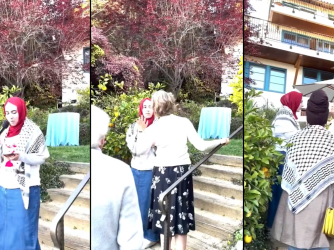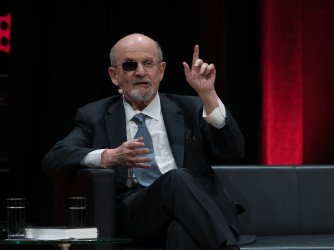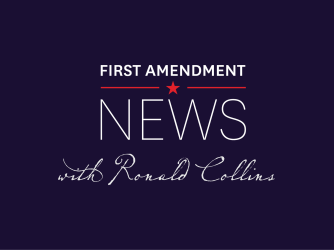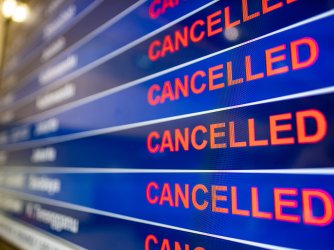Table of Contents
SUNY Oswego Journalism Student Suspended for Emails to Hockey Coaches
As FIRE has copiously documented in recent years, universities around the country have shown a dangerous tendency to conflate protected speech with unprotected true threats. The latest case in point comes from the State University of New York College at Oswego (SUNY Oswego), which leveled charges against a journalism student for writing a few short emails. Even with the low bar many other universities have set, SUNY Oswego's shocking decision to pursue threat charges stands out.
The student at the center of the latest storm is Alex Myers, an exchange student from Australia who worked as an intern in SUNY Oswego's Office of Public Affairs (OPA). Myers was also enrolled in an advanced-level course in SUNY Oswego's journalism department. For one of his class assignments, Myers was given the task of writing a feature on a public figure. Myers chose SUNY Oswego men's hockey coach Ed Gosek, and on October 17, Myers sent the following email to the hockey coaches at Cornell University, Canisius College, and SUNY Cortland:
My name is Alex Myers, I work for the Office of Public Affairs at SUNY Oswego.
I am currently writing a profile on Oswego State Hockey head coach Ed Gosek and was hoping to get a rival coaches view on Mr Gosek.
If you have time would you mind answering the following questions.
1. How do you find Mr Gosek to coach against?
2. Have you had any interactions with Mr Gosek off the ice? If so how did you find him?
3. What is your rivalry like between your school and Oswego State?
Be as forthcoming as you like, what you say about Mr Gosek does not have to be positive.
Cornell coach Michael Schafer replied that "saying your comments don't need to be positive is offensive." In response, Myers apologized, stating that he was "simply letting you know that this piece I am writing is not a 'puff' piece."
The next evening, Myers received a hand-delivered letter from SUNY Oswego President Deborah Stanley, informing him that he was being placed on interim suspension, effective at 6:00 p.m. October 19, and that he would have to vacate his dorm room by that time. The letter also banned him from all campus facilities and informed him that he may be subject to arrest if he came on campus.
Accompanying this letter was a statement of charges, outlining two alleged violations of SUNY Oswego's Code of Student Rights, Responsibilities and Conduct. The first charge, stemming from his emails' statement that he worked for OPA without the clarification that the profile he was writing was class-related, was for "dishonesty." According to SUNY Oswego policy, this conduct encompasses "academic dishonesty," "knowingly furnishing false information to the College," and "forgery or alteration or use of documents with intent to defraud," among other things.
The second, and far more drastic, charge was for "disruptive behavior." Among the behaviors that merit this charge are "harassment," "intimidation," "threats," "conduct which inhibits the peace or safety of members of the College community," and "retaliation, harassment or coercion." The charges further stated that:
Specifically: Campus network resources may not be used to defame, harass, intimidate, or threaten another individual or group.
Given the actual legal definitions of the classes of unprotected speech alleged in this statement, this charge was meritless and indefensible. FIRE wrote to President Stanley on October 26 to explain:
[I]t is abundantly clear that Myers' emails do not cross the threshold for any of the categories of unprotected speech SUNY Oswego has alleged. First, defamation, a narrow exception to the First Amendment that carries a specific legal definition, requires that the speaker make a knowingly false statement with the intent to injure the reputation of its target. But not only does Myers' email not make any false statements about Gosek, it doesn't make any factual statements about Gosek of any kind. Myers' brief email simply encouraged other coaches to speak freely about their interactions with Gosek, regardless of whether their experiences were positive. That Myers' email invited a frank and honest assessment of Gosek in no way brings it into the realm of defamation as defined under the law.
Nor does Myers' email constitute harassment. In Davis v. Monroe County Board of Education, 526 U.S. 629, 633 (1999), the Supreme Court fashioned a definition of student-on-student harassment in the educational setting that should guide SUNY Oswego here. In Davis, the Court defined harassment as conduct that is "so severe, pervasive, and objectively offensive that it effectively bars the victim's access to an educational opportunity or benefit." By definition, this includes only extreme and usually repetitive behavior-behavior so serious that it would prevent a reasonable person from receiving his or her education. The standard for determining student-employee harassment should be at least as stringent as the standard set in Davis, given the relative position of power and influence Gosek, an athletic coach, enjoys compared to Myers, a student. Yet Myers' emails clearly come nowhere close to even meeting the Davis standard.
Finally, threats and intimidation also have clear legal definitions, by which SUNY Oswego must abide. The Supreme Court has defined "true threats" as "those statements where the speaker means to communicate a serious expression of an intent to commit an act of unlawful violence to a particular individual or group of individuals." Virginia v. Black, 538 U.S. 343, 359 (2003). Likewise, Virginia v. Black states that "[i]ntimidation in the constitutionally proscribable sense of the word is a type of true threat, where a speaker directs a threat to a person or group of persons with the intent of placing the victim in fear of bodily harm or death." Id. at 360. A simple reading of the Supreme Court's guidance readily dispels any notion that Myers' emails constitute either threats or intimidation.
Alleging that Myers' emails could possibly have constituted any of these not only violates the First Amendment, it sends a deeply chilling message to students. How safe can student speech at SUNY Oswego possibly be if any criticisms of faculty, staff, or fellow students find their way to the wrong administrator? What if you're an enterprising student on assignment for the college's newspaper, The Oswegonian, asking probing questions in pursuit of a story?
Even more worrying is the possibility, if not likelihood, that SUNY Oswego reported Myers' case to its police department as well. Indeed, law enforcement was involved from the beginning: Chief of Police Cynthia Adam was among those copied to President Stanley's suspension letter. That clearly non-threatening emails can result in disciplinary sanctions for students is concerning enough; that SUNY Oswego would use its police to enforce such unjust sanctions as Myers faced is downright alarming.
Myers was ultimately allowed to stay on campus and continue attending classes, with limited access to other campus facilities, while awaiting his disciplinary hearing. But it's outrageous that SUNY Oswego ever thought such a punishment was merited in the first place, given the level of the "offense" committed. Aside from being morally wrong, it goes against SUNY Oswego's own guidelines for when interim suspension may be used as a punishment—i.e., when "the continued presence of the student would constitute a threat to the safety of persons or property on College premises, would pose a threat of disruption to the conduct of College activities or constitute a significant interference with the educational purposes of the College." I'd like to see SUNY Oswego try to make the case that because of his emails to a hockey coach, Myers posed such an immediate and significant threat that he required removal.
After receiving FIRE's letter on October 26, SUNY Oswego dropped the "disruptive behavior" charge at his hearing on October 29, leaving only the charge of "dishonesty." On this front, Myers admits that he substantially erred by not clarifying that he was writing an assignment for his journalism course, and that the writing was not related to his work at OPA. He gives the explanation that he had been in the habit of introducing himself in that manner when completing assignments for OPA, which often involved conducting interviews. (For example, Myers had written a number of "Campus Updates" that were published by OPA.) Myers had already apologized to OPA on October 18 for creating any impression that he had sent the emails on OPA's behalf.
On October 31, Myers was officially given a "warning" by SUNY Oswego, though one that came with strings attached. Myers is now required to complete an "education assignment," under the guidance of his journalism professor, "to share with other students in journalism classes that will share what you have learned from your experience." Further, he is required to write apology letters to SUNY Oswego hockey coach Ed Gosek, as well as to the three coaches he contacted for his assignment.
This is, of course, a far better outcome for Myers than he would likely have faced had he been found guilty of the "disruptive behavior" charge—which isn't to say I'm completely happy with it. FIRE is deeply wary of any kind of compelled speech as punishment, and we've seen it used numerous times to odious effect. Many such punishments are blatantly unconstitutional. Other times they're used a reminder of the administration's power over the student. Quite often they're both. The fact that Myers is being forced to apologize for protected speech makes this all the more troubling.
And besides, the case can easily be made that Myers has been punished more than enough. After all, he was forced to live with the possibility of a severely unjust punishment hanging over his head, placed on suspension, and ordered, at least initially, to vacate his dorm and leave campus under penalty of arrest. His internship with OPA was also terminated. And, of course, a police record of this incident may well still exist; the notation of his case number on the final page of Myers' warning letter strongly suggests police involvement in his case on at least an administrative level.
Seeking to put the incident behind him, Myers plans to complete the sanctions. But if apologies are on the table here, how about SUNY Oswego apologizing to Myers for treating him like a criminal and branding him a threat to the community when he clearly wasn't?
Recent Articles
FIRE’s award-winning Newsdesk covers the free speech news you need to stay informed.

No, the Berkeley Law student didn’t have a First Amendment right to interrupt the dean’s backyard party

Salman Rushdie calls out left-wing censorship in CBS interview

Falsely claiming a First Amendment right at a dinner party at private home — FAN 419.1
